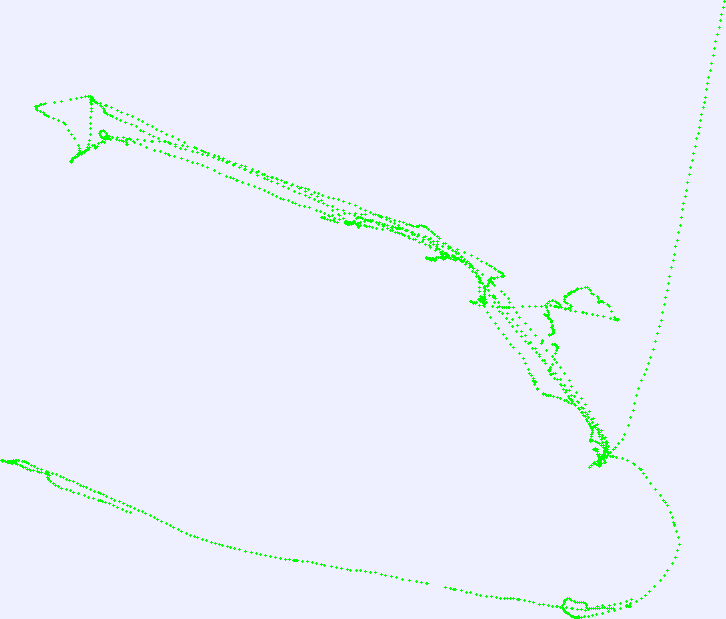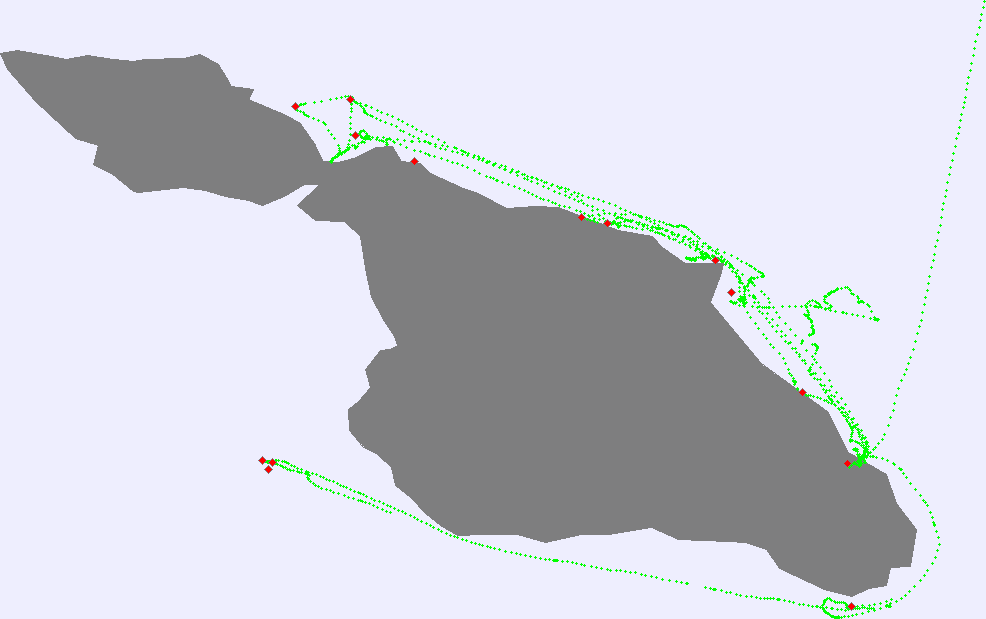Hack 70. Import Your GPS Waypoints and Tracklogs into GRASS


Use GRASS to tell the story of your travels on a customized map.
GRASS has a reputation as a complicated program that can do anything, but at the cost of hair-pulling pain. Here is a (relatively) simple guide to getting GRASS to do interesting things with your own GPS data. Along the way, we'll also convince GRASS to show us some interesting base-map layers as a way of providing context for our own story. By this point, you've probably loaded some waypoints and tracklogs from your GPS receiver onto your computer: now, let's import them into GRASS!
Before Version 5.7, GRASS referred to point data as "site" data, and there were s. commands to manipulate site data. As of Version 5.7, points are included in the much improved "Vector" format. A point is just the simplest vector. Some of the old s. sites commands now work with point data but store the points in the new vector format.
The s.in.ascii command imports text data into a vector file. You can specify a comma as your input field separator and import data that looks like this:
easting,northing,[attribute]
Data fields provided to s.in.ascii can also be separated by tabs, spaces, or an arbitrary separator of your choice. Meanwhile, here's an example of what we're starting with, a few lines of tracklog data downloaded via gpstrans.
Format: DDD UTC Offset: -8.00 hrs Datum[100]: WGS 84 T 03/03/2004 16:53:01 38.4018946 -122.8440571 T 03/03/2004 16:53:02 38.4018946 -122.8440785
After the header line, each line of data consists of four tab-separated fields: a data type (T, for tracklog), a timestamp, and a latitude/longitude pair. Use this quick Perl script to convert gpstrans output into a form that can be handled by s.in.ascii.
#!/usr/bin/perl
while (my $point = <>) {
chomp $point;
my ($type, $date, $lat, $long) = split / /, $point;
next unless $lat and $long;
print "$long,$lat,$date
";
}
Note that latitude and longitude are reversed in the output, because "easting" here is measured in degrees of longitude. Here is an extract from a tracklog that has been cleaned up to import into GRASS.
-122.8440571,38.4018946,03/03/2004 16:53:01 -122.8440785,38.4018946,03/03/2004 16:53:02
Now we import the tracklog into GRASS. First start GRASS and load the global data set with the U.S. state boundaries that we assembled in [Hack #69] .
GRASS:~/wa/gps > perl ./fix_track.pl tk_2004-03-03-rino.txt > temp.txt GRASS:~/wa/gps > s.in.ascii output=tracklog input=temp.txt fs=,
Let's see what's there:
GRASS:~/wa/gps > d.mon start=x0 GRASS:~/wa/gps > d.vect map=tracklog color=green size=2
I've used the d.zoom command to center the map over my area of interest, producing Figure 6-29.
Figure 6-29. Tracklog on Catalina Island

That is a record of a weeklong dive trip around Catalina Island off the coast of Southern California. Now let's add some context.
Here is a bit of a waypoint file.
-121.970944444444 37.3223055555556 HITHAI -122.829027777778 38.4025277777778 HOME
Note that now it is delimited with spaces, so the field separator (fs) is now set to space. We can import this into GRASS and display the waypoints, along with our states layer, with the commands:
GRASS:~/wa/gps > s.in.ascii output=waypoint input=wy102103.asc fs=space GRASS:~/wa/gps > d.vect map=states color=grey GRASS:~/wa/gps > d.vect map=tracklog color=green size=2 GRASS:~/wa/gps > d.vect map=waypoint icon=basic/diamond size=8 color=grey fcolor=red
Figure 6-30 shows all the components of our map together: the tracklog, the nearby waypoints, and the state borders underneath provide context.
Figure 6-30. Catalina tracklog with waypoints and base map

This map has one problem: tracks are displayed as discrete points. This gives the resulting maps a faint fairy-tracing appearance. I find the effect soothing, as it hints of an ambiguity in time and place. The GPS seems to speak to me, telling me, "Sure, I knew where you were at this moment, and then at this moment, and on through the day, but between those times, I don't know where you were." It is as though I traveled through a series of quantum jumps, disregarding intervening space (a trick that those driving the Nebraska panhandle will find themselves wanting to add to their travel kits).
See the next hack, [Hack #71] for a way to convert the discrete points to lines.
Mapping Your Life
- Hacks 1-13
- Hack 1. Put a Map on It: Mapping Arbitrary Locations with Online Services
- Hack 2. Route Planning Online
- Hack 3. Map the Places Youve Visited
- Hack 4. Find Your House on an Aerial Photograph
- Hack 5. The Road Less Traveled by in MapQuest
- Hack 6. Make Route Maps Easier to Read
- Hack 7. Will the Kids Barf?
- Hack 8. Publish Maps of Your Photos on the Web
- Hack 9. Track the Friendly Skies with Sherlock
- Hack 10. Georeference Digital Photos
- Hack 11. How Far? How Fast? Geo-Enabling Your Spreadsheet
- Hack 12. Create a Distance Grid in Excel
- Hack 13. Add Maps to Excel Spreadsheets with MapPoint
Mapping Your Neighborhood
- Hacks 14-21
- Hack 14. Make Free Maps of the United States Online
- Hack 15. Zoom Right In on Your Neighborhood
- Hack 16. Who Are the Neighbors Voting For?
- Hack 17. Map Nearby Wi-Fi Hotspots
- Hack 18. Why You Cant Watch Broadcast TV
- Hack 19. Analyze Elevation Profiles for Wireless Community Networks
- Hack 20. Make 3-D Raytraced Terrain Models
- Hack 21. Map Health Code Violations with RDFMapper
Mapping Your World
- Hacks 22-34
- Hack 22. Digging to China
- Hack 23. Explore David Rumseys Historical Maps
- Hack 24. Explore a 3-D Model of the Entire World
- Hack 25. Work with Multiple Lat/Long Formats
- Hack 26. Work with Different Coordinate Systems
- Hack 27. Calculate the Distance Between Points on the Earths Surface
- Hack 28. Experiment with Different Cartographic Projections
- Hack 29. Plot Arbitrary Points on a World Map
- Hack 30. Plot a Great Circle on a Flat Map
- Hack 31. Plot Dymaxion Maps in Perl
- Hack 32. Hack on Base Maps in Your Favorite Image Editor
- Hack 33. Georeference an Arbitrary Tourist Map
- Hack 34. Map Other Planets
Mapping (on) the Web
- Hacks 35-46
- Hack 35. Search Local, Find Global
- Hack 36. Shorten Online Map URLs
- Hack 37. Tweak the Look and Feel of Web Maps
- Hack 38. Add Location to Weblogs and RSS Feeds
- Hack 39. View Your Photo Thumbnails on a Flash Map
- Hack 40. Plot Points on a Spinning Globe Applet
- Hack 41. Plot Points on an Interactive Map Using DHTML
- Hack 42. Map Your Tracklogs on the Web
- Hack 43. Map Earthquakes in (Nearly) Real Time
- Hack 44. Plot Statistics Against Shapes
- Hack 45. Extract a Spatial Model from Wikipedia
- Hack 46. Map Global Weather Conditions
Mapping with Gadgets
- Hacks 47-63
- How GPS Works
- Hack 47. Get Maps on Your Mobile Phone
- Hack 48. Accessorize Your GPS
- Hack 49. Get Your Tracklogs in Windows or Linux
- Hack 50. The Serial Port to USB Conundrum
- Hack 51. Speak in Geotongues: GPSBabel to the Rescue
- Hack 52. Show Your Waypoints on Aerial Photos with Terrabrowser
- Hack 53. Visualize Your Tracks in Three Dimensions
- Hack 54. Create Your Own Maps for a Garmin GPS
- Hack 55. Use Your Track Memory as a GPS Base Map
- Hack 56. Animate Your Tracklogs
- Hack 57. Connect to Your GPS from Multiple Applications
- Hack 58. Dont Lose Your Tracklogs!
- Hack 59. Geocode Your Voice Recordings and Other Media
- Hack 60. Improve the Accuracy of Your GPS with Differential GPS
- Hack 61. Build a Map of Local GSM Cells
- Hack 62. Build a Car Computer
- Hack 63. Build Your Own Car Navigation System with GpsDrive
Mapping on Your Desktop
- Hacks 64-77
- Hack 64. Mapping Local Areas of Interest with Quantum GIS
- Hack 65. Extract Data from Maps with Manifold
- Hack 66. Java-Based Desktop Mapping with Openmap
- Hack 67. Seamless Data Download from the USGS
- Hack 68. Convert Geospatial Data Between Different Formats
- Hack 69. Find Your Way Around GRASS
- Hack 70. Import Your GPS Waypoints and Tracklogs into GRASS
- Hack 71. Turn Your Tracklogs into ESRI Shapefiles
- Hack 72. Add Relief to Your Topographic Maps
- Hack 73. Make Your Own Contour Maps
- Hack 74. Plot Wireless Network Viewsheds with GRASS
- Hack 75. Share Your GRASS Maps with the World
- Hack 76. Explore the Effects of Global Warming
- Conclusion
- Hack 77. Become a GRASS Ninja
Names and Places
- Hacks 78-86
- Hack 78. What to Do if Your Government Is Hoarding Geographic Data
- Hack 79. Geocode a U.S. Street Address
- Hack 80. Automatically Geocode U.S. Addresses
- Hack 81. Clean Up U.S. Addresses
- Hack 82. Find Nearby Things Using U.S. ZIP Codes
- Hack 83. Map Numerical Data the Easy Way
- Hack 84. Build a Free World Gazetteer
- Hack 85. Geocode U.S. Locations with the GNIS
- Hack 86. Track a Package Across the U.S.
Building the Geospatial Web
- Hacks 87-92
- Hack 87. Build a Spatially Indexed Data Store
- Hack 88. Load Your Waypoints into a Spatial Database
- Hack 89. Publish Your Geodata to the Web with GeoServer
- Hack 90. Crawl the Geospatial Web with RedSpider
- Hack 91. Build Interactive Web-Based Map Applications
- Hack 92. Map Wardriving (and other!) Data with MapServer
Mapping with Other People
- Hacks 93-100
- Hack 93. Node Runner
- Hack 94. Geo-Warchalking with 2-D Barcodes
- Hack 95. Model Interactive Spaces
- Hack 96. Share Geo-Photos on the Web
- Hack 97. Set Up an OpenGuide for Your Hometown
- Hack 98. Give Your Great-Great-Grandfather a GPS
- Hack 99. Map Your Friend-of-a-Friend Network
- Hack 100. Map Imaginary Places
EAN: 2147483647
Pages: 172
